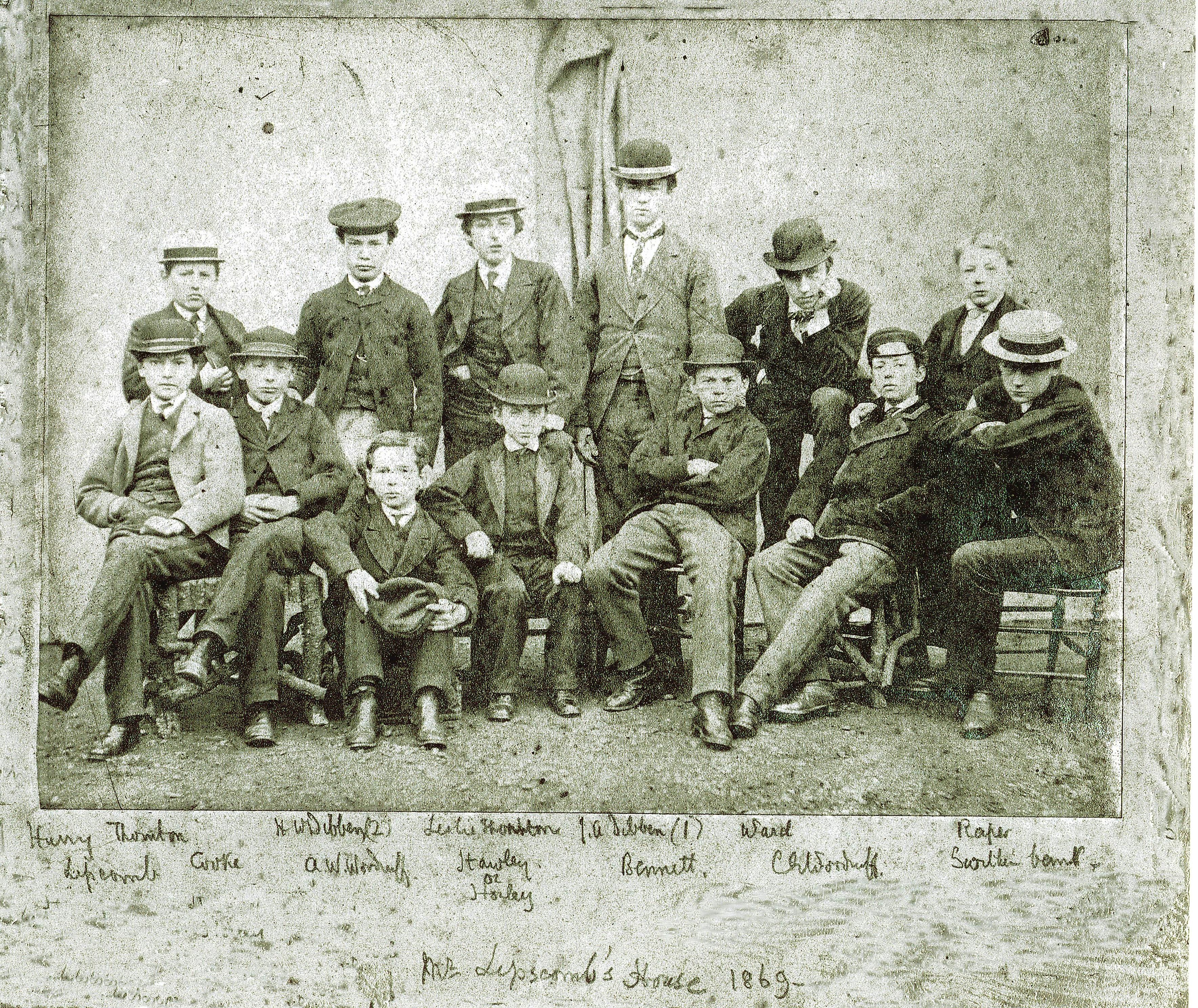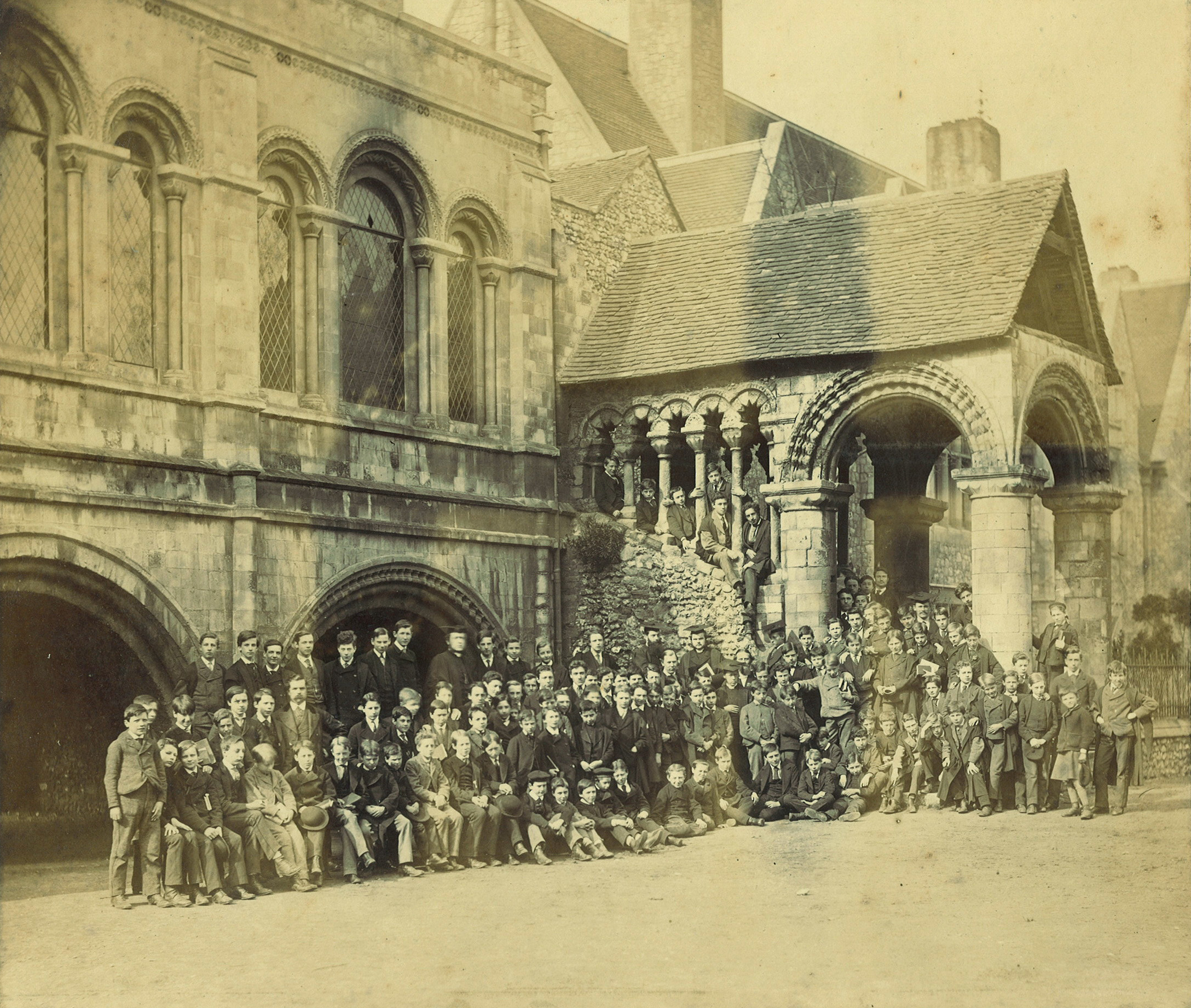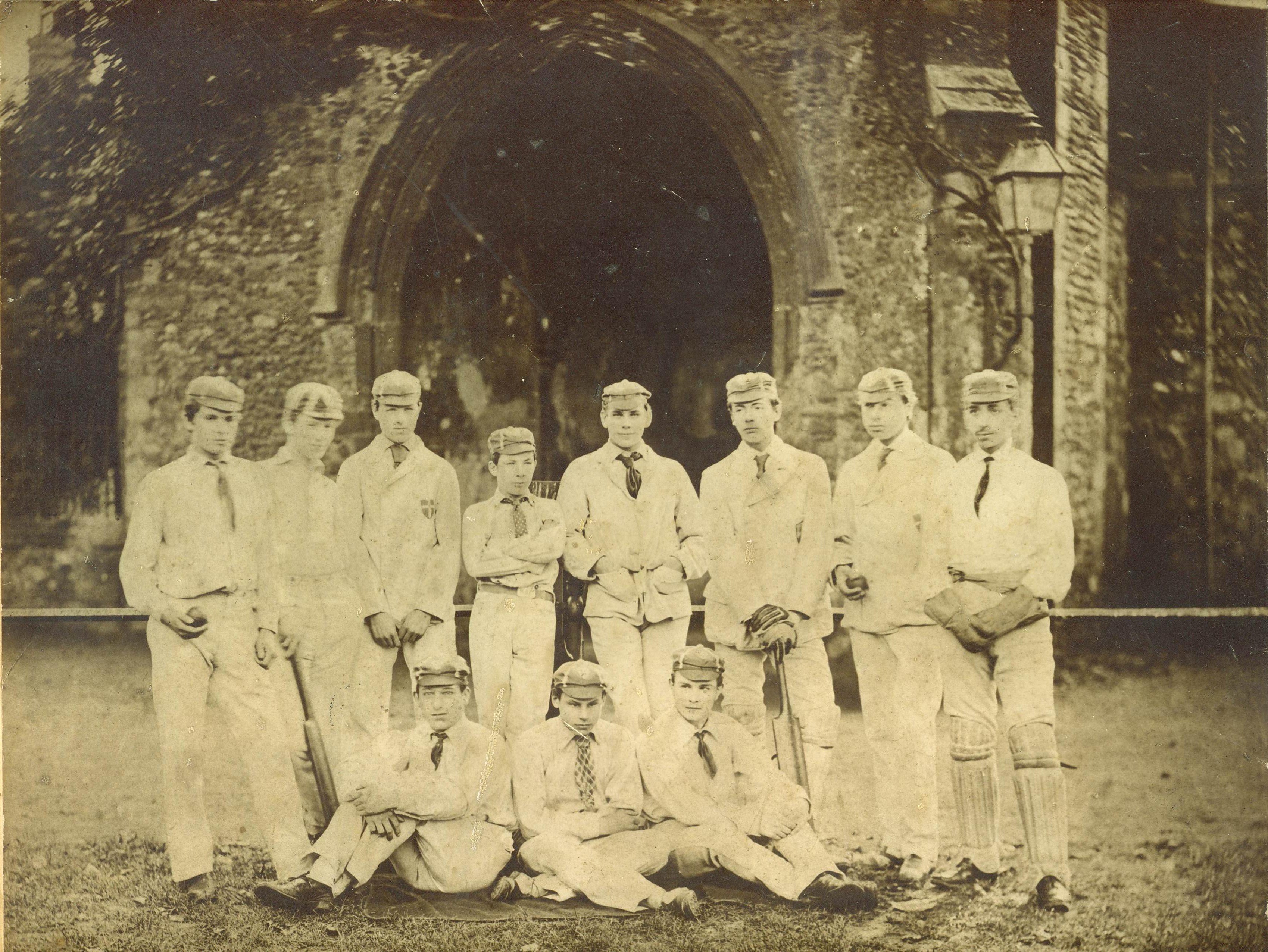When I was asked by the Editors of The Cantuarian to contribute to its pages my reminiscences of the School as it was when I first entered it, now upwards of 75 years ago, I felt highly honoured, for though my family has had a long connection with the School (my father was a King’s Scholar when the Battle of Waterloo was fought and my grandfather was under Dr. Osmund Beauvoir, a contemporary of Dr. Samuel Johnson), none of us can claim to have attained any great distinction either at School or subsequently. But it was not false modesty that made me at first demur to the Editors’ proposal, but the fact that the condition of the School during the seven years in which I was a member of it had already been fully described in the School History (published in 1908), especially in Chapters IX and X, written, respectively, by Dr. T. Field and W. G. Morse, both of whom were my contemporaries. This I pointed out to the Editors, who, however, declined to accept the above excuse for non-compliance with their request, pleading that I must be able to produce much matter supplementary to the above, or have some message to deliver to the scholars of the present day.
I am not at all confident that I can add much to what has been admirably described in the chapters referred to, but since when one can’t get off doing an imposition, it is wise to sit down at once and write it, I will now adopt that course and attempt the task.
I entered the School after the Michaelmas holidays in the year 1868, for in those days there was a break of a fortnight in the term succeeding the summer holidays, which began and ended much earlier than they now do. The number of boys in the School at this time was about 120, of whom nearly half were day-boys. The old Almonry buildings, which had housed the School since Elizabethan days, had been demolished a few years before my time. I never saw them, but they were situated on the south side of the Mint Yard on the left hand side of the way leading to the great Norman Gateway. The new buildings, comprising the Headmaster’s residence with accommodation for 60 boarders, had been erected on the north side of the Yard a few years earlier. There were no buildings at that time on the western side of the Yard except the Porter’s lodge, from a window of which ‘Mother Obee’ dispensed hot meat pies, sausage rolls, and other ‘tuck’ during the matutinal interval of ten minutes at 10.30 a.m.
The southern side of the Yard was occupied by the house of the Second Master, which was practically identical with that now known as “The Grange,” less of course the additions made when Dr. Galpin was Headmaster. It was to this house that I came as a boarder in 1868, – John Streatfield Lipscomb being at that time Hypodidascalus. It was a small house, having accommodation for only sixteen boarders. Our dormitory was not divided up into cubicles, but a longitudinal partition, about six feet high, divided it into two halves with eight beds on either side, an arrangement admirably adapted for races between competitors on either side of the partition. There was a custom, too, as I soon discovered, of tossing new boys in a blanket, an experience I did not find particularly unpleasant. These sports could of course be safely indulged in only when Mr. Lipscomb was ‘dining out’, for he was a strict disciplinarian; but it is curious that there was no monitor in the house. There were no sumptuary rules with regard to dress in those days. We wore what we liked, or rather what our parents thought suitable. Evidence for this is found in a photographic group of the fourteen boys who were my school-fellows in those far-off days – the variety of head-gear is remarkable. Four are wearing black ‘bowlers’ (two of which are adorned with coloured ribbons), two have grey bowlers, one a Scot’s cap with tails, one a white straw hat, and two, including myself, have black cloth caps with glazed leather peaks!
Mr. Lipscomb was an excellent teacher and a loveable man. Field sums up his merits as a teacher thus: “How many a·passage of Horace or Hecuba recalls the adjustment of the eye-glass, the contraction of the fine features, or else the swinging phrase in which the translation came, and made one feel for the first time there was some sense in it.” Unfortunately, bad health produced occasional fits of irritability which sometimes resulted in explosions of unnecessary violence. I remember one such occasion which caused some amusement at the time. Provoked by some crass stupidity, Lipscomb struck a boy on the cheek while holding a lead pencil in his hand. The lead entered the boy’s cheek, broke off, and remained there. At dinner on the same day, Lipscomb, noticing a black mark on the boy’s face, said “H–, you have not washed your face.”
“Yes sir, I have.”
“What then is that black mark on your cheek?”
“That, sir, is where your pencil went in.”
Lipscomb of course was horrified, and made an ample apology.
Mr. Lipscomb died in 1871, and was buried in St. Martin’s Churchyard, the whole School attending his funeral.
Another ancient photograph that is still in my keeping exhibits the whole School, masters and boys, grouped in front of the Norman Staircase. It must have been taken in 1873, just before the resignation of the Headmastership by Dr. Mitchinson. The spare form of the little “Governor,” as we called him, is to be seen in the foreground:
Ecce gubemator parvus cum veste fluente
Qui primi scamni calfacit auriculas.
But the warming-up was not confined to the First Form; it extended from the First to the Fifth, other parts of the body besides the ears were at different times subjected to painful stimulation. John Mitchinson, D.C.L., Fellow of Pembroke College, Oxford, Honorary Canon of Canterbury Cathedral, and Headmaster of the King’s School from 1859 to 1873, and later Bishop of Barbadoes, was a man of great intellectual ability, boundless energy, and inflexible will power, but there was also in him a touch of sadism which made the infliction of pain on others a positive pleasure to him. Under his forceful rule many of his scholars obtained a remarkable number of Academic successes. These are summed up in the School History as twenty-nine Scholarships at Oxford or Cambridge; at Oxford eight First Classes in Moderations, Six in Final Schools, four Fellowships; the Derby, Hertford, Taylorian and Denyer and Johnson University Scholarships; the Chancellor’s prizes for the English, and for the Latin Essay (twice), and also (twice) the Hall Houghton, and the Ellerton Essay. Surely a wonderful list for a School numbering less than 150 boys!
Taking another look at the photographic group, I notice a little boy in the foreground, with downcast head and folded hands, – that is Edwin Joad, a protégé of Mitchinson, who followed the Bishop to the Barbadoes, where he had a rather distinguished career at Codrington College, and later became a Government Inspector of Schools in England, and the father of Professor C.E.M. Joad, so widely known as a prominent member of the B.B.C. ‘Brains Trust.’
Reverting for a moment to the Mint Yard, I must say something about the house at its south-east corner, now called ‘Latter Gate’, which during my schooldays was occupied by Mr. Godfrey-Faussett, Auditor and Chapter Clerk to the Dean and Chapter. Godfrey Faussett, who had been a Fellow of Corpus Christi College, Oxford, and was an excellent classical scholar, was a man of extremely nimble wit, a close personal friend of Mr. Lipscomb, through whom some of his witticisms reached us boys. This one I still remember. When the new Chapter library (now alas, destroyed by enemy action) was nearly completed, the Dean and Chapter decided to have their several coats of arms carved on the stone mantelpiece. For the guidance of the sculptor, each Canon sent in sketches of his armorial bearings, except Canon Stone, who had gone abroad without giving a pattern to the sculptor, so instead of his bearings, the shield appropriated to him displayed the following lines in pencil:-
Mitte supervacuum sculpendi monstra laborem, Ipse potest lapidem significare lapis.
On the next day the following translation or paraphrase of the above lines came from the Auditor’s pen:-
Chyde not; O friend, that mid th’ armoriall hoste
Sculptur’d and blazon ‘d I am blank alone: Beautie when unadorn’d is beautie moste,
So stone uncarv’d best representeth Stone.
Another jeu d’esprit by Faussett was one connected with the Ashantee War of 1873, when Sir Garnet Wolsey was advancing on Coomassie, the capital of the country. King Coffee escaped, leaving the town in flames. Faussett’s commentary was: Coomassie’s town is burnt to dust; The King escaped is he:
So dust and Coffee now remain
Of what was Ashantee.
Besides being a scholar and a wit, Faussett was also a learned antiquary. His library and collection of Anglo-Saxon relics were stored in the room over the Norman Gateway leading to the Green Court.
Turning to the School games, there is little I can add to the description given·in the School History. Football was played in the Green Court, the goals being placed diagonally from the south-west corner to the north-east corner of the Court. The rules were akin to those of “Rugger,” but with some variations that made it difficult for visiting teams to understand our peculiarities. I do not think we played any Schools; against Clubs we generally had the assistance of at least two of the Masters, but this was in the early days of my school career: a little later the Rugby code was adopted in its entirety. Hockey was also played on the Green Court both before and after the football season; but it was of a rather primitive kind, – the goals being merely indicated by strips of white paint on the brick walls; that on the western wall had the letters “L.G.” painted between the vertical strips, and that on the eastern wall (now demolished) near The Forrens Gate, the letters “U.G.” The letters of course meant lower goal and upper goal, but when new boys asked their meaning they were generally told: “Why L.G. = Lovely Girls, U.G. = Ugly Girls!” Our Fives Court occupied the site of the present ‘Gym.’; it was of unorthodox dimensions, but afforded a very good game.
With regard to Cricket, we had the good fortune to be allowed to play on the County ground which, though then possessing few of the amenities it has since acquired (the pavilion was merely a wooden shed), provided capital wickets. There were three, and only three School Elevens. Somehow or other I got into the third, and about the year 1872 was so fortunate as to attract the notice of Mr. C. Cobb, O.K.S., who at that time was helping the Headmaster with the work of the Sixth Form. Cobb, who was himself a very useful cricketer, was also an excellent cricket coach. He taught me to play with a straight bat, and so greatly did I profit by his instruction, that in the following year I became a member of the first eleven, and its captain the last two years of my school days. In 1875 we had a particularly strong team, so much so that seven years later The Cantuarian, commenting on the successes of that year (1882) described the season as the “most successful the School has had since 1875, when C.E. Woodruff captained the best eleven the School has ever produced”!
Attendance at the Cathedral services occupied no inconsiderable portion of our lives in those far-off days. We were present on Saints-days in the morning, on Saturday afternoons, and on Sundays at 10.30 a.m. and 3 p.m. The service on Sunday morning generally lasted for nearly two hours, and in the winter months the great Church was bitterly cold, – the hot water pipes were not put in until the year 1870. Nevertheless, I thoroughly enjoyed the musical portions of the services. Our seats were between the Canons’ stalls and the Choristers, but at an earlier date the K.S. boys had occupied the front row on either side of the Choir, where on the hard black oak of their desks they carved their names or initials, though how they managed to do it undetected is a mystery I have never been able to explain. These desks, which were part of the pewing erected in the reign of Queen Anne, were transferred to the King’s School, when the Choir was re-seated by Sir Gilbert Scott in 1878, and set up in the School-room (now Library), where I believe they still remain.
In my day the front row of seats on the Cantoris side – near the Lectern, was occupied by the girls of the Charity School, wearing blue cloaks and white mob caps. Opposite to them, on the Decani side, sat the boys of the Blue Coat School, clad in blue tunics girded with leathern belts, whom we called the “Little Policemen.”
The central passage or alley through the Choir was encumbered by benches, called the “Free Seats,” which on Sunday afternoons were generally well filled with the humbler citizens, especially when Dean Alford was the preacher. The stone staircase which now forms the approach to the N.E. transept of the Cathedral was not in existence in my early school days, a wooden one occupied its place, which after dark in the winter months was lighted by a single gas-burner placed about 6ft. above the steps. On a particularly dark evening, as we were coming down the staircase, one Parkinson, a very tall boy of the Fifth Form, put out the light by turning the tap with his toe (no inconsiderable acrobatic feat), leaving those behind, including masters, to jostle out as best they could. On our return to the Mint Yard, we were all bidden to go up into the ‘School,’ where Dr. Mitchinson held an enquiry as to the perpetrator of the outrage, with the result that “P.” confessed he had done it for a wager –whereupon “P.” was told to fetch the cane. When the weapon arrived, the criminal was bidden to hold out his hand: he did so, but at the level of his shoulder, which was at about the same height as the top of Dr. Mitchinson’s head, thereby effectually reducing the strength of the blow. “Lower, sir, lower!” vociferated the Headmaster, but though “P.” temporarily obeyed, he took care to raise his arm again before the next blow fell, with the result that his chastisement lost much of the sting that his foolish prank deserved.
Well, I think I have now written quite as much as the Editors will care to print. So I conclude, as I began, by reminding the readers of these reminiscences that the rest of the Acts of the King’s School, the work they did, and the games they played 78 years ago, are they not written in the book of the School History (Chapters IX, X and XIII)?
To the present generation, these records of School life as it was three-quarters of a century ago, may give the impression that it was a poor life, since so many things, now deemed essential, were not dreamed of in those days. School life was certainly harder then than it is to-day, but this I know, I was happy, for I learned that life is good if you know how to live it, and that is about the best thing a boy can learn. Joy teaches him to mould life. Indifference, pettiness, miserableness, envy, sneering, are not of her family. Joy knows not those poisoners of the wells of life.
Floreat Schola.
Charles Eveleigh Woodruff (1855-1948) was the son of the Revd John Woodruff. He entered the King’s School in 1868 and left in 1875. He went to Oriel College, Oxford and was ordained. From 1907 he was Honorary Librarian to the Dean and Chapter of Canterbury. He co-authored the history of the School Schola Regia Cantuariensis, published in 1908. These reminiscences were published in The Cantuarian, April 1946.



